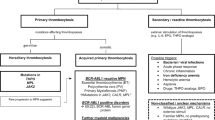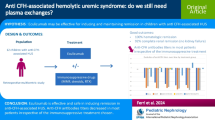Abstract
Background
Idiopathic thrombocytopenic purpura (ITP) is an autoimmune disorder for which appropriate diagnostic treatments are uncertain. The response to splenectomy varies from 60% to 90%, and the remaining patients relapse and require further treatment. Therefore, it is important to predict the outcome of splenectomy before and after surgery. The objective of this study was to evaluate the efficacy of splenectomy in patients diagnosed with ITP.
Materials and Methods
From 1988 to 2004, we splenectomized 32 patients with ITP; 17 underwent laparoscopic splenectomy (LS) and 15 underwent conventional open splenectomy (OS). For analysis, patients were separated retrospectively into two groups: the “responding group,” those who showed good outcomes with splenectomy, and the “non-responding group,” those who did not show good outcomes with splenectomy. Blood samples were examined before and immediately after surgery (day 0) and on postoperative days (POD) 1, 3, 5, and 7.
Results
The median follow-up was 8.3 years (range: 1–16 years). The overall 5- and 10-year survival rates after splenectomy were 96.9% (one death). The responding group included 24 patients (75%), and the non-responding group included 7 (21.9%). Platelet counts in the responding group increased gradually until POD 7, and although platelet counts in the non-responding group were almost constant until POD 5, they subsequently decreased until POD 7. Average platelet counts in the responding and non-responding groups were 269 and 124 × 109/l on POD 7, respectively (P < 0.05). The pre- to post-surgery ratio of platelet counts were almost the same as the result of the actual data. Platelet counts during the long-term follow-up for the responding and non-responding groups were related to those noted on discharge.
Conclusions
A high platelet count on POD 7 was associated with a good response to splenectomy, but age at surgery, the time interval between diagnosis and splenectomy, and prior responses to corticosteroid were not. We suggest that long-term outcomes of splenectomy can easily be predicted by platelet counts on POD 7.





Similar content being viewed by others
References
Fenaux P, Caulier MT, Hirschauer MC, et al. Reevaluation of the prognostic factors for splenectomy in chronic idiopathic thrombocytopenic purpura (ITP): a report on 181 cases. Eur J Haematol 1989;42:259–264
Najean Y, Ardaillou N. The sequestration site of platelets in idiopathic thrombocytopenic purpura: its correlation with the results of splenectomy. Br J Haematol 1971;21:153–164
Akwari OE, Itani KM, Coleman RE, et al. Splenectomy for primary and recurrent immune thrombocytopenic purpura (ITP). Current criteria for patient selection and results. Ann Surg 1987;206:529–541
Gugliotta L, Isacchi G, Guarini A, et al. Chronic idiopathic thrombocytopenic purpura (ITP): site of platelet sequestration and results of splenectomy. A study of 197 patients. Scand J Haematol 1981;26:407–412
Diaz J, Eisenstat M, Chung RS. Laparoscopic resection of accessory spleen for recurrent immune thrombocytopenic purpura 19 years after splenectomy. J Laparoendosc Surg 1996; 6:337–339
Mazzucconi MG, Arista MC, Peraino M, et al. Long-term follow-up of autoimmune thrombocytopenic purpura (ATP) patients submitted to splenectomy. Eur J Haematol 1999;62:219–222
Szold A, Schwartz J, Abu-Abeid S, et al. Laparoscopic splenectomies for idiopathic thrombocytopenic purpura: experience of sixty cases. Am J Hematol 2000;63:7–10
Cines DB, Blanchette VS. Immune thrombocytopenic purpura. N Engl J Med 2002;28;346:995–1008
Maloisel F, Andres E, Zimmer J, et al. Danazol therapy in patients with chronic idiopathic thrombocytopenic purpura: long-term results. Am J Med 2004;116:590–594
Delaitre B, Maignien B. Splenectomy by the laparoscopic approach. Report of a case Presse Med 1991;20:2263
Friedman RL, Hiatt JR, Korman JL, et al. Laparoscopic or open splenectomy for hematologic disease: which approach is superior? J Am Coll Surg 1997;185:49–54
Park A, Marcaccio M, Sternbach M, et al. Laparoscopic vs open splenectomy. Arch Surg. 1999;134:1263–1269
Watson DI, Coventry BJ, Chin T, et al. Laparoscopic versus open splenectomy for immune thrombocytopenic purpura. Surgery 1997;121:18–22
Berchtold P, McMillan R. Therapy of chronic idiopathic thrombocytopenic purpura in adults. Blood 1989;74:2309–2317
Zoghlami-Rintelen C, Weltermann A, Bittermann C, et al. Efficacy and safety of splenectomy in adult chronic immune thrombocytopenia. Ann Hematol 2003;82:290–294
Bourgeois E, Caulier MT, Delarozee C, et al. Long-term follow-up of chronic autoimmune thrombocytopenic purpura refractory to splenectomy: a prospective analysis. Br J Haematol 2003;120:1079–1088
Najean Y, Rain JD, Billotey C. The site of destruction of autologous 111In-labelled platelets and the efficiency of splenectomy in children and adults with idiopathic thrombocytopenic purpura: a study of 578 patients with 268 splenectomies. Br J Haematol 1997;97:547–550
Najean Y, Dufour V, Rain JD, et al. The site of platelet destruction in thrombocytopenic purpura as a predictive index of the efficacy of splenectomy. Br J Haematol 1991;79:271–276
Zimmer J, Andres E, Noel E, et al. Current management of adult idiopathic thrombocytopenic purpura in practice: a cohort study of 201 patients from a single center. Clin Lab Haematol 2004;26:137–142
El-Alfy MS, El-Tawil MM, Shahein N. 5- to 16-year follow-up following splenectomy in chronic immune thrombocytopenic purpura in children. Acta Haematol 2003;110:20–24
Vianelli N, Valdre L, Fiacchini M, et al. Long-term follow-up of idiopathic thrombocytopenic purpura in 310 patients. Haematologica 2001;86:504–509
Portielje JE, Westendorp RG, Kluin-Nelemans HC, et al. Morbidity and mortality in adults with idiopathic thrombocytopenic purpura. Blood 2001;97:2549–2554
Machado MA, Makdissi FF, Herman P, et al. Exposure of splenic hilum increases safety of laparoscopic splenectomy. Surg Laparosc Endosc Percutan Tech. 2004;14:23–25
Kercher KW, Novitsky YW, Czerniach DR, et al. Staple line bleeding following laparoscopic splenectomy: intraoperative prevention and postoperative management with splenic artery embolization. Surg Laparosc Endosc Percutan Tech 2003;13:353–356
Iwase K, Higaki J, Yoon HE, et al. Splenic artery embolization using contour emboli before laparoscopic or laparoscopically assisted splenectomy. Surg Laparosc Endosc Percutan Tech 2002;12:331–336
Totte E, Van Hee R, Kloeck I, et al. Laparoscopic splenectomy after arterial embolisation. Hepatogastroenterology 1998;45:773–776
Author information
Authors and Affiliations
Corresponding author
Rights and permissions
About this article
Cite this article
Ojima, H., Kato, T., Araki, K. et al. Factors Predicting Long-term Responses to Splenctomy in Patients with Idiopathic Thrombocytopenic Purpura. World J. Surg. 30, 553–559 (2006). https://doi.org/10.1007/s00268-005-7964-0
Published:
Issue Date:
DOI: https://doi.org/10.1007/s00268-005-7964-0




